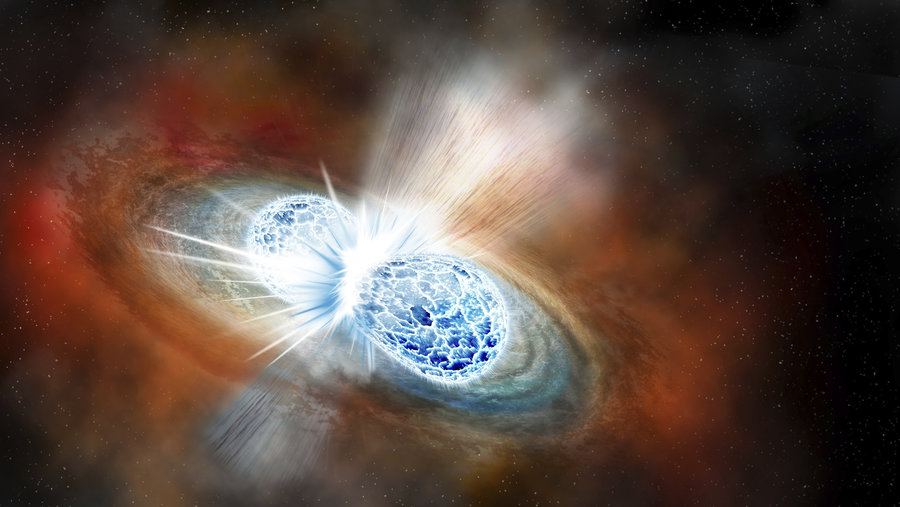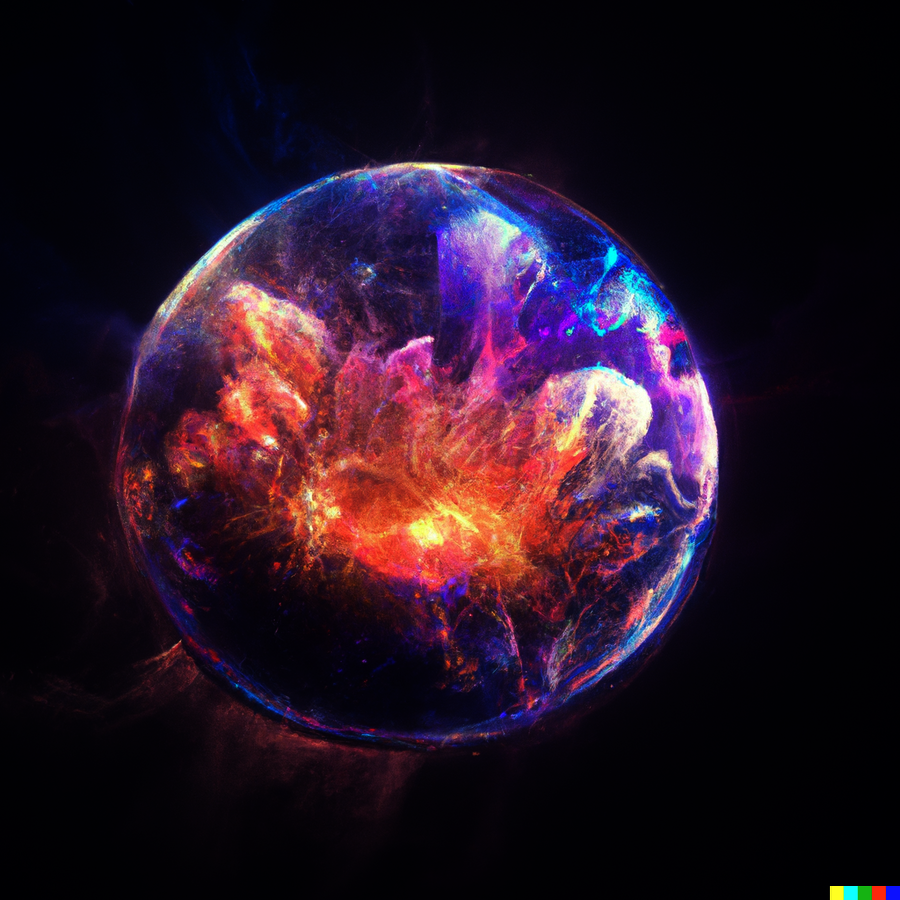The perfect explosion in space — The mystery of the spherical kilonova
20.02.2023 |
When neutron stars collide, they produce an explosion that, contrary to what was believed until recently, is shaped almost like a perfect sphere. Although how this is possible is still a mystery, the discovery may provide a new key to measuring the age of the Universe. The discovery was made by an international collaboration with participation of researchers of the GSI Helmholtzzentrum für Schwerionenforschung in Darmstadt and led by astrophysicists from the University of Copenhagen. The result has been published in the journal Nature.
Kilonovae are giant explosions occurring when two neutron stars orbit each other and finally collide. The occurring extreme physical conditions are responsible for creating heavy elements, e. g. the atoms in gold jewelry and the iodine in our bodies. Furthermore, kilonovae produce light, which allows for the observation of the explosions with telescopes even at cosmic distances.
But there is still a great deal we do not know about this violent phenomenon. When a kilonova was detected at 140 million light-years away in 2017, it was the first time scientists could gather detailed data. Scientists around the world are still interpreting the data from this colossal explosion, including Albert Sneppen and Professor Darach Watson from the University of Copenhagen, as well as Privatdozent Andreas Bauswein and Dr. Oliver Just of GSI’s Theory research department.
One of the open questions concerns the geometrical shape of the kilonova, i.e. the propagation velocity of the explosion in different directions. This problem has been addressed by the international research team led by Sneppen and Watson. The researchers have analyzed the velocity of the explosion in different directions: along the line of sight — that is, the velocity of the material moving towards our Earth — and perpendicular to it.
Along the line of sight, the researchers take advantage of the Doppler effect known from approaching fire trucks. Just as the pitch of the siren changes at high speed, the properties of the light from the kilonova explosion, or more precisely from the so-called spectral lines, can be used to determine the velocity. The velocity perpendicular to the line of sight results from the size of the emitting area, which can be derived from the brightness and color of the kilonova.
The spherical shape is a mystery
The analysis surprises: The explosion spreads equally fast in all directions. The kilonova from 2017 is shaped like a sphere. “You have two super-compact stars that orbit each other 100 times a second before collapsing. Our intuition, and most previous models, say that, due to the enormous angular momentum in the system, the explosion cloud created by the collision must have a rather asymmetrical shape,” says Albert Sneppen, PhD student at the Niels Bohr Institute and first author of the study published in the journal Nature. How the kilonova can be spherical is a real mystery.
The GSI team in particular contributed simulations of the explosion to test different scenarios and theoretical interpretations to the publication. The researchers were able to show that, even under somewhat speculative assumptions, there is no mechanism that will necessarily lead to a spherical explosion, although some simulations fit the observation quite well. “Therefore, one possibility could also be that it is pure coincidence. In any case, the observation is exciting because it helps to better understand models of the kilonova explosion and thus the details of element synthesis in these events,” says Oliver Just. Andreas Bauswein adds: “With further measurements of neutron star mergers, we will certainly be able to better assess this result. We expect that with new observatories now available, many additional kilonovae will be discovered in the coming years.”
A New Cosmic Ruler
The shape of the explosion is also interesting for an entirely different reason: “Among astrophysicists there is a great deal of discussion about how fast the Universe is expanding. The speed tells us, among other things, how old the Universe is. And the two most commonly used methods that exist to measure it disagree by about a billion years. Here we may have a third method that can complement and be tested against the other measurements,” says Albert Sneppen.
The so-called “cosmic distance ladder” is the method used today to measure how fast the Universe is growing. This is done simply by calculating the distance between different objects in the universe, which act as rungs on the ladder. “If they are bright and mostly spherical, we can use kilonovae as a new way to measure the distance independently – a new kind of cosmic ruler,” says Darach Watson and continues: “Knowing what the shape is, is crucial here, because if you have an object that is not spherical, it emits differently, depending on your sight angle. A spherical explosion provides much greater precision in the measurement.”
The study is a first result of the newly founded HEAVYMETAL collaboration, which was recently awarded an ERC Synergy grant. (CP)
About kilonovae
- Neutron stars are extremely compact stars that consist mainly of neutrons. They are typically only about 20 kilometers across, but weigh one and a half to two times as much as the Sun. A teaspoon of neutron star matter weighs about as much as Mount Everest.
- When two neutron stars collide, the phenomenon of a kilonova occurs. It is a radioactive, bright fireball that expands at enormous speed and consists mostly of heavy elements formed in the merger and its aftermath. These newly formed elements are ejected into space and mix with gas clouds, which form a new generation of stars and planets.
- Element synthesis in kilonovae was predicted in 1974. In 2017, detailed data from a kilonova was obtained for the first time, when the detectors LIGO (in the USA) and Virgo (in Europe) succeeded in measuring gravitational waves from a neutron star merger and thus indicating the position of the kilonova in the sky. Telescopes then discovered the kilonova AT2017gfo close to a galaxy 140 million light years away.















